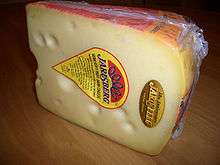Jarlsberg cheese
| Jarlsberg | |
|---|---|
 | |
| Country of origin | Norway |
| Region | Jarlsberg |
| Source of milk | Cow's |
| Texture | Semi-soft |
Jarlsberg (Norwegian pronunciation: [ˈjɑːɭsˈbærɡ]; English /ˈjɑːrlzbɜːrɡ/) is a mild cow's-milk cheese with large regular holes, that originates from Jarlsberg, Norway.[1] Although it originated in Norway, it is also produced in Ohio[2] and Ireland[3] under licenses from Norwegian dairy producers.
Description
Jarlsberg cheese has a yellow-wax rind (outer layer) and a semi-firm yellow interior. It is a mild, buttery cheese.[4] The flavor has been described as "clean and rich, with a slightly sweet and nutty flavour".[1] It is an all-purpose cheese, used for both cooking and eating as a snack. It has a characteristic smooth, shiny-yellow body, and a creamy supple texture. It is aged a minimum of one year and is distinguished by medium to large holes.[5] It is usually produced in 10 kg wheels with an approximate diameter of 330 mm and a height of 95-105 mm.[1] The characteristic holes or "eyes" are the result of the action of the bacteria Propionibacterium freudenreichii which naturally occurs in milk and is added back to the cheese during production according to a closely guarded secret formula.[1][6][3]
History
The history of this cheese can be traced back to the middle 1850s.[7] Anders Larsen Bakke (1815–1899), a farmer and pioneer in Norway's dairy industry, produced cheese in the village of Våle in what was then the county of Jarlsberg and Larviks Amt (now Vestfold), 80 km (50 mi) south of Oslo.[7] The cheese shares similarities with Emmental, introduced to Vestfold by Swiss cheese makers during the 1830s.[4] The cheese was first noted in the annual county report of Jarlsberg and Larviks Amt in 1855.[7] After several years of popularity marked by a large volume of production Jarlsberg disappeared from the market.[4]
Modern Jarlsberg cheese was developed in 1956 by Ole Martin Ystgaard of the Dairy Institute at the Agricultural University of Norway.[8] Ystgaard's interest was sparked by the thesis of a dairy sciences student, Per Sakshaug, on the cheese historically made in Vestfold.[7] It was named for a Norwegian nobleman Count Wedel Jarlsberg (or the eponymous county) who owned land near Oslo in an area where an earlier version of the cheese was produced in the early 1800s.[8][4] The recipe was developed from formulae originating with Swiss cheesemakers who moved to Norway in that time.[1]
Production and distribution
"Jarlsberg" is a trademark first registered by Tine SA in 1972,[9][10] and the exact nature and formula for the process of making Jarlsberg cheese is a trade secret.[6] The largest producer of Jarlsberg cheese is Tine SA. Tine is the largest Norwegian dairy product cooperative.[8][11] Jarlsberg cheese accounts for 80% of Tine's total export. Tine's United States subsidiary, Norseland, has sold 150 million 22 lb (10 kg) wheels of Jarlsberg cheese in the U.S. as of 2004.[8]
Jarlsberg cheese was introduced in the United States in 1964.[8] Imports to the U.S. in 1965 were 25 million pounds (11,000,000 kg).[8] Since 1979 imports to the U.S. have been limited to 15 million pounds (6,800,000 kg).[8] Jarlsberg is the most popular imported cheese in the U.S.[12][6] As of 2004, 5–10 million pounds (2,300,000–4,500,000 kg) of Jarlsberg cheese was made in the U.S. in Ohio.[8][2] It is also produced in Ireland by Dairygold.[3]
Annual sales of Jarlsberg cheese in the United Kingdom are £6.9m as of 2013.[6] Jarlsberg cheese is also popular in Australia.[13]
See also
References
- 1 2 3 4 5 Rage, Arnfinn (1999). "Ch. 8: North European Varieties of Cheese § 4. Norwegian Cheese Varieties. 6. Jarlsberg". In Fox, P.F. Cheese: Chemistry, Physics and Microbiology. Vol. 2: Major Cheese Groups. Springer Science+Business Media. pp. 259–60. ISBN 9780834213395.
- 1 2 Hebert, Kristy (July 1, 2004). "Slice of Norway in Ohio cheese". Farm and Dairy. Retrieved 2016-09-17.
- 1 2 3 Blume, Aimee (February 2, 2012). "Cheese of the Week: Jarlsberg a good substitute for Swiss". Evansville Courier & Press. Retrieved May 3, 2014.
- 1 2 3 4 Kipfer, Barbara Ann (2012). The Culinarian: A Kitchen Desk Reference. Houghton Mifflin Harcourt. p. 318. ISBN 0544186036.
- ↑ "Jarlsberg Cheese 1 lb § Product Description" (product order page). Widmer's Cheese Cellars.
- 1 2 3 4 Cloake, Patricia (September 12, 2013). "The hole truth about Jarlsberg cheese". Word of Mouth. The Guardian (blog). Retrieved August 3, 2014.
- 1 2 3 4 Ehlers, Steve; Hurt, Jeanette (2008). "Part 2: Old World Favorites. Ch. 10: Scandinavian and Baltic Cheeses § Norwegian Jarlsberg and Other Norsk Favorites". The Complete Idiot's Guide to Cheeses of the World. Dorling Kindersley. pp. 102–3. ISBN 9781440636189.
- 1 2 3 4 5 6 7 8 Maar, Nancy T. (June 20, 2004). "Jarlsberg's Stamford, Conn., importer eyes U.S. growth". The Advocate. Stamford, CT. Knight Ridder/Tribune Business News. Retrieved August 3, 2014 – via HighBeam Research. (subscription required (help)).
- ↑ "Detaljer". search.patentstyret.no. Retrieved 2016-02-13.
- ↑ "Jarlsberg". Webster's New World Dictionary (online ed.). John Wiley & Sons. 1998. Retrieved August 3, 2014 – via HighBeam Research. (subscription required (help)).
- ↑ Ranscombe, Peter (February 10, 2013). "Vet kit to keep Jarlsberg cows healthy". Scotland on Sunday. Retrieved August 3, 2014 – via HighBeam Research. (subscription required (help)).
- ↑ Jenkins, Steven W. (1996). "The Scandinavian Countries". Cheese Primer. Workman. p. 443. ISBN 9780894807626.
- ↑ "Jarlsberg grows in the gourmet market". Australasian Business Intelligence. Comtex. 2004 – via HighBeam Research. (subscription required (help)).
External links
- Jarlsberg.com U.S. site of brand owner.